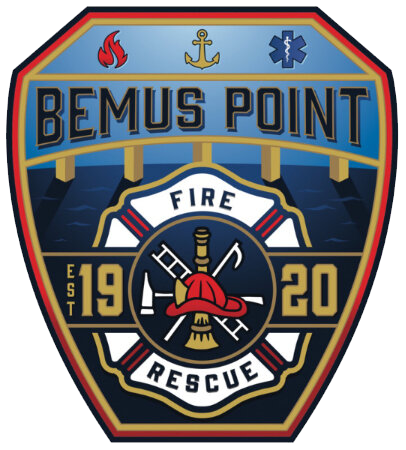About US
Station 44
The Bemus Point Volunteer Fire Department (BPVFD) is a volunteer fire department located in the village of Bemus Point, NY, a lakeside community of rural homes, seasonal cottages, a small resort village with restaurants, and a Victorian era wooden hotel. Other modern structures include commercial sized lakeside establishments such as a dual structure, four-story condo complex housing facility, an elementary school, a two-story senior and handicapped individual housing facility, and multiple lakeside dual story restaurants. BPVFD is located in Chautauqua County, amongst 41 other fire departments that are split into four battalions. Established in 1920, the fire department was founded as a resolution by the Bemus Point Village Trustees, serving the community for just shy of 100 years. A popular tourist location, the village attracts thousands of people during the warmer third of the year.
The Bemus Point Fire Department serves one of the most famous destinations in America for sport boating, fishing and tourism. Lake Chautauqua in western New York (42 09' 22 N, 79 23' 44 W) is a 17-mile-long body of fresh water with a unique, centrally located constricted area. Traversing this relatively narrow portion of the lake is the Veterans Memorial Bridge, completed in October of 1982, which facilitates the passage of a heavy volume of personal and commercial traffic along Interstate 86. The fire district includes the only highway interchange in Chautauqua County. The rural community surrounding the village is home to dairy farms, corn and grass fields, and woodlots. Homes receive water via private wells, and there is no municipal water or hydrant system. All water for firefighting is obtained from dry hydrants at the lake, or brought in via tanker shuttle from mutual aid departments. There is also an FAA medic helicopter pad within a mile of our district area.
Although the department is equipped for firefighting and water and ice rescue, our EMS call volume remains high and continues to increase. BPVFD annually answers over 225 alarms. At a time when many U.S. volunteer fire departments are suffering from dwindling interest and membership, a recent influx of young recruits has swelled BPVFD's membership to 39 active members with 21 interior firefighters, 10 EMTs, and 4 ALS care providers. The department is on the verge of training several more interior firefighters and EMT's in the coming months.
Uniquely equipped, BPVFD has a Boston Whaler fire boat for unusual, rapid-response summer lake emergencies, and an air-propeller boat for winter over-ice rescues. Boat fires, boat accidents, drownings, searches, cold-water rescues, hazmat incidents, etc. are handled by our marine units. Weekly in-house fire/rescue training classes are taught and are well attended. Numerous multi-department trainings are scheduled annually.
Within the last year, the BPVFD has completed numerous purchases and a multitude of training sessions aimed at consolidating rescue equipment on one unit to increase tactical effectiveness and efficiency. These upgrades have included a full set of vehicle extrication cutting and spreading tools powered by Holmatro, a full set of cribbing, vehicle stabilization equipment, and modern lighting. These purchases complement the equipment already on the apparatus, which includes a magnitude of high-pressure airbag capabilities and small air-powered cutting tools (Whizzer saw / air-chisel, etc.).
We have better prepared ourselves for fire-related emergencies by purchasing a full fleet of new self-contained breathing apparatus (SCBA’s) from Churchville Fire Equipment with thermal imaging on every airpack, multiple higher powered smoke ejector fans, firefighter assist and search team (FAST) packs, better hand tools, and new personal protective equipment. BPVFD members train every Tuesday night with the exception of the monthly meeting which transpires one Tuesday per month. Members train to remain proficient in the most basic and most advanced parts of our job!
Our department chain of command structure consists of a Chief Engineer, three Assistant Chiefs, two Captains, and two Lieutenants. We operate with a traditional, top down hierarchy in which the highest-ranking officer holds command on the scene. In the event the chief engineer is not present, an assistance chief will hold command, etc.
Our line officers (i.e Captains and Lieutenants) lead the crews of rank-in-file on the scene, performing the operations assigned by the incident commander. On larger scenes, an Operations officer will be assigned. An operations officer functions directly under Command, leading the physical tasks being performed on scene to mitigate an emergency. This decreases the cognitive workload on the commanding officer, and allows them to step back and view the larger picture of a developing incident. In a large and expanding incident, additional roles in the command structure may be needed, such as a staging area manager, EMS operations chief, and more.
We have numerous Fire Police members who operate independently under the commanding officer. The department also has a safety officer who reports to the commanding officer, and functions to ensure department operations are conducted in the safest manner possible. To learn more about training opportunities with BPVFD, CLICK HERE.


















